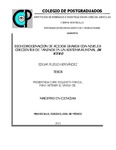| dc.description.abstract | El objetivo del presente estudio fue determinar el grado de biohidrogenación de los ácidos grasos presentes en el aceite de oliva (AO) por bacterias ruminales, con la inclusión de taninos condensados (TC) en un sistema ruminal in vitro usando alfalfa (Al) como sustrato. Se evaluaron tres niveles de inclusión (0, 2.5 y 5 %) de AO y de TC, respectivamente, en un diseño completamente al azar con arreglo factorial 3 x 3, generando nueve tratamientos, T1= 0% AO, 0% de TC y 100% Al; T2= 0% AO, 2.5% TC y 97.5% Al; T3= 0% AO, 5% TC y 95% Al; T4= 2.5% AO, 0% TC y 97.5% Al; T5= 2.5% AO, 2.5% TC y 95.0% Al; T6= 2.5% AO, 5% TC y 92.5% Al; T7= 5% AO, 0% TC y 95% Al; T8= 5% AO, 2.5% TC y 92.5% Al; T9= 5% AO, 5% TC y 90% Al; Se determinó el perfil de ácidos grasos del medio de cultivo al final de la incubación in vitro (72 h), pH, nitrógeno amoniacal (N-NH3), la producción de metano (CH4), degradación in vitro de la materia seca (DIVMS) y desaparición de FDN y FDA. Las medias de los tratamientos fueron comparadas con la prueba de Tukey (P <0.05). La concentración de ácido oleico se incrementó (P<0.05) a medida que incrementaron los niveles de aceite y de taninos condensados. Los niveles más altos (P<0.05) de linoleico y linolénico se registraron en el tratamiento T3, observándose valores de 8.51 y 7.47 mg 100 mg-1, para linoleico y linolénico, respectivamente. Cuando se incrementaron los niveles de aceite y taninos se registraron los niveles más bajos (P<0.05) de linoleico (T4, T7, T8 y T9) y linolénico (T4 y T7). Los tratamientos evaluados no afectaron (P>0.05) el pH de los medios de cultivo, pero la concentración de N-NH3 si mostró cambios (P<0.05) entre tratamientos, observándose las concentraciones más altas en el T7 y las más bajas en el T6 y T9. Así mismo, la mayor (P<0.05) producción de metano se presentó en el tratamiento testigo (T1, 0.3608mMol) y los tratamientos T6 y T9 propiciaron la mayor reducción de este gas (0.2243y 0.2337mMol, respectivamente). La DIVMS a las 72 h mostró cambios (P<0.05) y fue más alta en los tratamientos T1, T4 y T7, y la DIVMS más baja se presentó en los tratamientos T9, T6 y T8. La desaparición in vitro de la FDN fue más alta (P<0.05) en los tratamientos T3, T5, T6, T8 y T9 y la más baja (P<0.05) en T1 y T4. La desaparición in vitro de la FDA fue mayor (P<0.05) en T3, T6 y T8 y la menor (P<0.05) se observó en T1, T2 y T7. Este estudio demuestra que la biohidrogenación del ácido oleico en un medio ruminal in vitro no es afectada por la presencia de niveles de 2.5 y5% de taninos condensados; sin embargo, esta concentración de taninos si afecta parcialmente la biohidrogenación del ácido linoleico y de forma significativa la de linolénico, la concentración de nitrógeno amoniacal y la producción de metano. _______________ FATTY ACIDS BIOHYDROGENATION IN IN VITRO RUMEN SYSTEM WITH INCREASING LEVELS OF TANNINS. ABSTRACT: The aim of this study was to determine the degree of biohydrogenation of fatty acids of olive oil (OO) by rumen bacteria with the inclusion of condensed tannins (CT) in an in vitro rumen system using alfalfa (Al) as substrate. Three levels of inclusion were evaluated (0, 2.5, and 5%, for OO and CT, respectively) in a completely random design with 3 x 3 factorial arrangement, resulting in nine treatments: T1= 0% OO, 0% CT, and 100% Al; T2= 0% OO, 2.5% CT, and 97.5% Al; T3= 0% OO, 5% C, and 95% Al; T4= 2.5% OO, 0% CT, and 97.5% Al; T5= 2.5% OO, 2.5% CT, and 95.0% Al; T6= 2.5% OO, 5% CT, and 92.5% Al; T7= 5% OO, 0% CT, and 95% Al; T8= 5% OO, 2.5% CT, and 92.5% Al; T9= 5% OO, 5% CT, and 90% Al. The fatty acid profile of the culture medium was determined at the end of the in vitro incubation (72 h), as well as pH, ammonia nitrogen (N-NH3), methane (CH4) production, in vitro degradation of dry matter (IVDDM), NDF, and ADF. The means of the treatments were compared with the Tukey test (P<0.05). The concentration of oleic acid increased (P<0.05) as the levels of oil and condensed tannins increased. The highest levels (P<0.05) of linoleic and linolenic acids were registered in treatment T3, with values of 8.51 and 7.47 mg 100 mg-1, for linoleic y linolenic acid, respectively. When the levels of oil and tannins increased, the lowest levels (P<0.05) of linoleic (T4, T7, T8, and T9) and linolenic (T4 and T7) acids were registered. The evaluated treatments did not affect (P > 0.05) the pH of the culture, although the N-NH3 concentration did change (P<0.05) between treatments, with the highest concentrations in T7 and the lowest in T6 and T9. Likewise, the highest (P<0.05) methane production was in the control treatment (T1, 0.3608 mMol) while treatments T6 and T9 showed the greatest decrease of the gas (0.2243 and 0.2337 mMol, respectively). The IVDDM changed (P<0.05) at 72 h and was highest in treatments T1, T4, and T7, while the lowest IVDDM was in treatments T9, T6, and T8. The highest (P<0.05) in vitro disappearance of NDF was in treatments T3, T5, T6, T8, and T9, while the lowest (P<0.05) was in treatments T1 and T4. In vitro disappearance of ADF was greater (P < 0.05) in T3, T6, and T8, while the lowest (P < 0.05) was in T1, T2, and T7. This study demonstrates that the oleic acid biohydrogenation in an in vitro rumen medium is not affected by the presence of 2.5 and 5% condensed tannins; however, tannins affects linoleic and linolenic acid biohydrogenation, ammonia nitrogen concentration and methane production. | es_MX |


